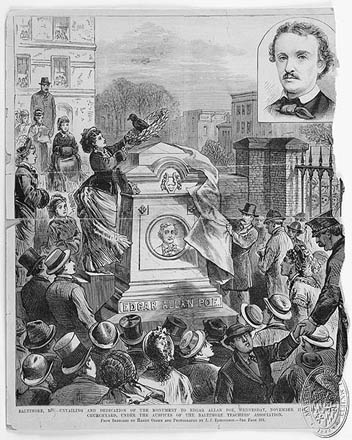Works in Baltimore |
|
|---|---|
 |
|
Name: |
Edgar Allan Poe Monument |
| Address: | Westminster Cemetery |
| Standing? Yes | Year: 1874 |
By 1865, a movement had begun, under the leadership of Sara Sigourney Rice, to provide for a new monument to Baltimore's neglected poet. Through a combination of pennies accumulated by students, gifts from friends and a variety of benefits, half of the necessary amount was raised by 1871. The remainder was donated by George W. Childs of Philadelphia in 1874. The monument was designed by Frederick and executed by the same Hugh Sisson who had worked once before on Poe's behalf. This time only one accident befell his creation—Poe's birthday is erroneously given as January 20 rather than January 19. (Although several possibilities were suggested by the likes of Oliver Wendell Holmes and James R. Lowell, the new monument has no epitaph, only the names and dates of its occupants.) After some discussion on the most appropriate location for the imposing edifice, it was decided that it would be best to use the front corner of the cemetery. (The church, built around 1855, would have blocked the view of the grave from the street if Poe was left in his grandfather's lot. There was also a small problem of securing rights to enough surrounding space, most of which was already occupied.) The monument was dedicated on November 17, 1875. Among those in attendance were John H. B. Latrobe (one of the judges who awarded Poe the Baltimore Saturday Visiter prize in 1833), Judge Neilson Poe (Edgar's cousin) and Walt Whitman (the great American poet, who actually met Poe once). Letters from H. W. Longfellow, John G. Whittier, William C. Bryant and Alfred Tennyson were read. The remains of Virginia Poe, buried in 1847 in New York, were brought to Baltimore and added to those of Poe and Maria Clemm in 1885. Thus the three who had struggled together as a family for so many years were reunited for eternity. In 1913, Orrin C. Painter placed another stone, intended to mark Poe's original burial site, in the rear of the church. For uncertain reasons, this stone was initially misplaced completely outside of the Poe family lot. It was quickly moved to a more reasonable but still dubious location. Perhaps in part due to this confusion, but mostly because people simply love a good mystery, a strange rumor has persisted that the memorial committee failed to exhume Poe's remains, instead moving those of some other poor soul. The improbability of this notion is obvious when one realizes that the exhumation in 1875 was supervised by George W. Spence, the man who buried Poe in 1849, and Poe's cousin Neilson Poe, who attended the original funeral. In the intervening 25 years, both men had frequently been called upon to take visitors to see Edgar's grave and were unlikely to have had the opportunity to forget the correct spot. Although no headstone ever marked Poe's grave, the cemetery itself is quite small and the traditional site of the grave is framed by the marble slab of the Reverend Patrick Allison at the left and a prominent mausoleum behind. |
|

